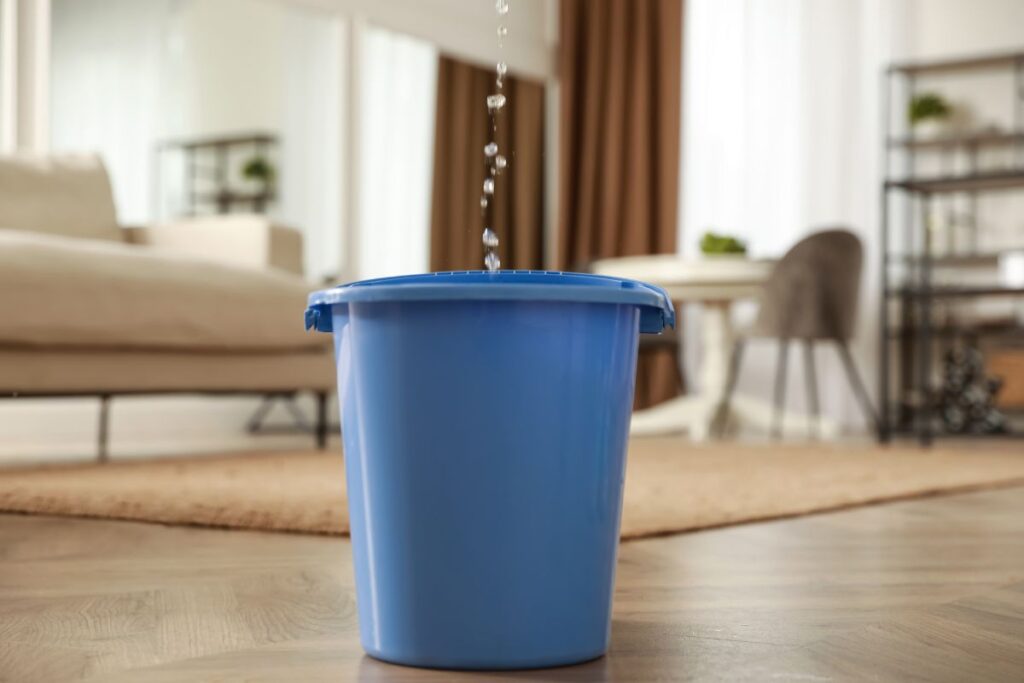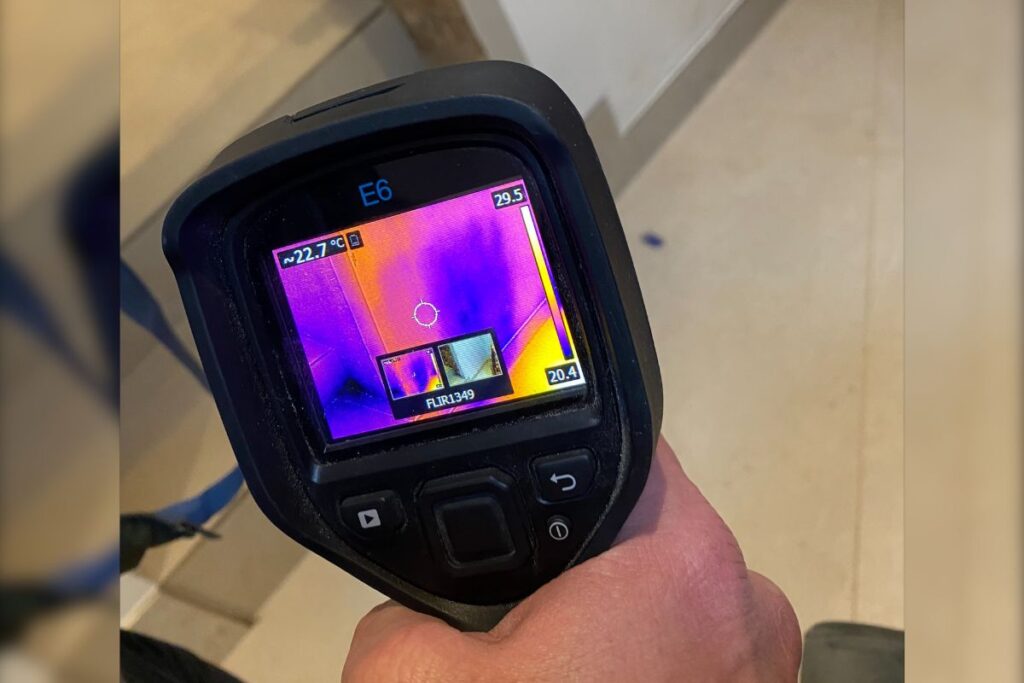
Water damage is a serious concern for both residential and commercial property owners.
It can strike unexpectedly and, if left unaddressed, can lead to significant structural issues, health hazards, and costly repairs.
Identifying and treating water damage early is crucial in protecting your property and ensuring its longevity.
In this article, we’ll explore the signs of water damage, how Vinci Response’s experts can diagnose the problem using advanced tools like thermal imaging cameras, and the effective remediation techniques we employ to restore your property to its original condition.
What Is Water Damage?
Water damage occurs when excess moisture infiltrates the structural components of a building, causing deterioration and potential hazards.
This can happen for various reasons, such as leaks, floods, burst pipes, or prolonged exposure to high humidity.
Over time, water can weaken materials like wood, drywall, and insulation, leading to rot, mould growth, and compromised structural integrity.
If not addressed promptly, water damage can escalate, causing extensive harm to the property and posing health risks due to mould and bacteria growth.
Identifying and treating water damage early is crucial to maintaining a safe and stable environment in any building.
Sign of Water Damage
Recognising the early signs of water damage is essential for preventing further deterioration and costly repairs.
Here are some common indicators to watch for in both residential and commercial properties:
- Discolouration: Yellow, brown, or dark spots on walls, ceilings, or floors suggest that water has infiltrated the building materials and has been present for some time.
- Peeling or Bubbling Paint: Moisture trapped behind paint can cause it to peel, bubble, or blister. This is a clear sign that water has permeated the surface layers.
- Warped or Swollen Walls and Floors: Water damage can cause wood and drywall to warp, leading to uneven floors, bulging walls, or cracked tiles. This is often a sign of significant moisture saturation.
- Musty Odours: A persistent musty smell usually indicates the presence of mould or mildew, which thrives in damp environments created by water damage.
- Visible Mould Growth: Mould can appear as black, green, or white patches on walls, ceilings, or floors. Its presence indicates prolonged exposure to moisture.
- Pooling Water or Puddles: Unexplained water accumulation in areas such as basements, under sinks, or near appliances can signal a leak or other water intrusion problem.
- Increased Humidity: A noticeable increase in indoor humidity levels, often accompanied by condensation on windows or surfaces, may indicate water infiltration.
These signs can vary in severity, but they all point to potential water damage that needs immediate attention to prevent further issues.
Identifying the Source of Water Damage
It is not straightforward to pinpoint the exact source of water damage in a building. Water can travel along various paths, seeping into hidden areas and causing damage far from the initial point of entry.
Identifying the root cause can be challenging without the right expertise and tools.
Misidentifying the source can lead to incomplete repairs, allowing the problem to persist or reoccur.
At Vinci Response, our team of experts utilises advanced techniques and specialised equipment to diagnose the source of water damage accurately. Here are some of the key methods we employ:
Thermal Imaging Cameras (FLIR E6)

Thermal imaging is one of the most effective tools for detecting hidden moisture.
The FLIR E6 camera captures temperature variations in building materials, which can indicate the presence of moisture.
This non-invasive method allows us to identify wet areas behind walls, under floors, and in ceilings without damaging the structure.
By visualising temperature differences, we can trace water to its source, even if it’s hidden from view.
Moisture Profiling
Moisture profiling involves the use of moisture meters to measure the moisture content in various building materials.
This method helps us determine the extent of water penetration and identify areas that may not yet show visible signs of damage.
By creating a detailed moisture profile of the affected area, we can better understand the scope of the issue and target the specific areas that need drying and remediation.
Leak Detection Equipment
In cases where the source of water damage is elusive, such as in complex plumbing systems or roofing, Vinci Response employs advanced leak detection equipment.
These tools, including acoustic sensors and tracer gas systems, can locate leaks within walls, underground, or hard-to-reach places, ensuring no potential water entry point is overlooked.
Endoscopic Cameras
Endoscopic cameras allow us to visually inspect the interior of walls, ceilings, and other cavities for particularly challenging cases where the water source is suspected to be within small or inaccessible spaces.
This precise method helps us locate leaks or moisture buildup without causing unnecessary damage.
By combining these advanced diagnostic tools with our extensive experience, Vinci Response can accurately identify the source of water damage.
This ensures that we address the problem at its origin, preventing further damage and providing a long-lasting solution for both residential and commercial properties.
Remediating Water Damage with Vinci Response
Once the source of water damage has been accurately identified, the next crucial step is remediation.
At Vinci Response, we employ advanced techniques to remove moisture, restore damaged areas, and protect your property from future water-related issues.
Our team is equipped with the latest technology and expertise to handle both minor water intrusion and severe flooding scenarios.
Here’s how we can help:
Construction/commercial building Drying
Construction drying is a comprehensive approach used to dry out large areas or entire structures affected by water damage.
We utilise high-powered trailer-mounted desiccant dehumidifiers or heat trailers and air movers to remove moisture from the air and surrounding materials.
This method is particularly effective in drying out walls, floors, and ceilings, preventing the growth of mould and mildew.
By reducing humidity levels, construction drying helps to stabilise the building’s environment, ensuring that all surfaces are thoroughly dried and ready for any necessary repairs.
Pressure Drying
Pressure drying is a specialised technique for removing moisture trapped in cavities within walls, ceilings, and floors.
This method involves creating a pressure differential that forces warm, dry air into the wet areas, accelerating the evaporation of moisture.
It’s particularly useful for drying spaces that are difficult to access with standard equipment.
By focusing on these hidden areas, pressure drying helps prevent long-term damage and reduces the risk of mould growth.
Suction Drying
Suction drying, also known as negative pressure drying, is an effective method for extracting moisture from floor voids, insulation floors and floating floors, by creating a vacuum and extracting excess water.
By pulling moisture out of these materials, suction drying not only removes excess water but also minimises the potential for structural damage and mould development.
It’s a crucial step in remediation, particularly in severe water damage scenarios.
Mould Remediation
Vinci Response offers professional mould remediation services in cases where water damage or excess moisture has led to mould growth.
Our team follows industry best practices to safely remove mould from affected areas, using specialised equipment and techniques to ensure that spores do not spread to other parts of the building.
We also treat the area to prevent future mould growth, helping safeguard the health of occupants and maintain the property’s structural integrity.
Structural Repairs and Restoration
After the moisture has been removed, our team can assess any structural damage caused by the water and provide the necessary repairs.
Whether it’s replacing damaged drywall, restoring warped flooring, or repairing compromised ceilings, Vinci Response has the expertise to return your property to its pre-damage condition.
We work efficiently to minimise downtime and disruption, ensuring that your home or business is back to normal as quickly as possible.
Why Choose Vinci Response?
At Vinci Response, we understand that water damage can be a stressful and overwhelming experience.
That’s why we’re committed to providing a comprehensive and efficient service to address all aspects of water damage remediation.
From our initial assessment using advanced diagnostic tools to the application of industry-leading drying and restoration techniques, we ensure that every step of the process is handled with the utmost care and professionalism.
Whether dealing with minor water damage or a major flood, Vinci Response has the solutions to restore your property and protect it from future water-related issues.
Contact us today to learn how we can help you with your water damage remediation needs.